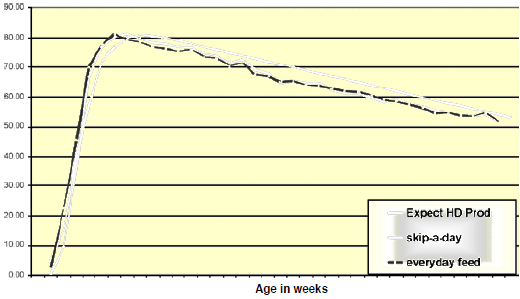



Skip-a-Day and Everyday Feed Programs for Broiler Breeders in the Hen House
Dr Keith Bramwell, extension poultry specialist at the University of Arkansas reports recent work comparing various feed restriction progammes for broiler breeders. His article was published in the Summer 2008 issue of Avian Advice.Introduction

Controlling body weight in replacement broiler breeders and breeders in the hen house is a portion of the poultry industry that will continue to evolve. Because of the genetic potential for growth in modern breeders, methods to control body weight and uniformity within a flock continue to receive attention in an effort to improve, or at least maintain reproductive performance.
In the United States, feed restricting pullets and young cockerels primarily involves one of several forms of a skip-a-day feeding program. The use of skip-a-day feeding in the pullet house often occurs in an effort to uniformly distribute small amounts of feed throughout the house to allow all birds’ equal and immediate access to feed allotments. If feed distribution does not occur in a uniform and even fashion, this can result in poor uniformity of body weight and body conformation among the pullets and cockerels. While the technology and equipment exists to uniformly distribute small feed allotments, it is not found in the majority of pullet houses in the United States. When pullets and cockerels exhibit poor uniformity in the pullet house, this often translates to poor performance in the hen house as the maturation process is uneven and therefore all birds will not respond to reproductive stimuli the same. Therefore, various versions of skip-a-day feeding is still common place in the poultry industry.
As replacement breeders are moved to the hen house, the most common practice in the U. S. is to begin providing feed allotments on an everyday basis. However, in other countries, and occasionally in the U. S., the use of skip-a-day feeding may continue in the hen house in an effort to maintain bird uniformity and further control feed distribution prior to the onset of egg production. These programs usually involve feeding one of various versions of skip-a-day feeding until first egg or 5% production is attained. When utilized, the most common skip-a-day program in the hen house is a 5- 2 feeding schedule, as this seems to be a sort of combination between the traditional true skip-a-day and everyday feeding.
Research Trial Design
At the University of Arkansas Broiler Breeder Research Farm a trial was designed to draw a direct comparison between everyday fed and 5-2 skip-a-day fed birds following housing in the hen house. This trial involved a total of 4080 Cobb 500 pullets which were raised together and according to industry recommendations. At 21 weeks of age, pullets were moved to a single production style hen house and randomly divided into 48 pens with 24 replicate pens of 85 hens per pen for each of the two feed treatment groups. Both groups were fed the same quality and quantity of feed per bird per week (feed allotments and feed formulations according to industry standards) with the skip-a-day fed birds receiving their weekly feed allotments in five days rather than seven. The 5-2 fed birds had two ‘off feed’ days each week each of which followed either two or three consecutive feed days. Once 5% egg production was attained for each individual treatment group, each group was fed into production the same and according to industry recommendations. All conditions and feed programs were the same for both feed treatment groups through 60 weeks of age.
Production results
As was expected, the onset of egg production was delayed in the skip-a-day fed group. The onset of egg production in the skip-a-day group occurred five days later than the everyday fed group and therefore peak in egg production was delayed as well (Figure 1). However, the skip-a-day fed group was able to maintain egg production following peak and followed a similar egg production trend. The periodic egg production results in Table 1 show that while the skip-a-day group came into production five days later and attained peak production several days later, by 30 weeks of age cumulative eggs produced per hen housed was similar. Additionally, at the conclusion of the 60 week production cycle, there was no significant difference in total eggs produced per hen housed.

| Table 1. Cumulative egg production per hen in skip-a-day versus everyday fed breeder hens through 60 weeks of age. | |||||||
| Feed Program |
Weeks of Age
|
||||||
| 30 | 35 | 40 | 45 | 50 | 55 | 60 | |
| Skip-a-day fed | 25.18 | 51.62 | 75.69 | 97.26 | 117.15 | 135.50 | 148.45 |
| Every-day fed | 25.67 | 51.60 | 75.14 | 96.41 | 116.19 | 134.25 | 147.09 |
Hen mortality for the trial was relatively low with 8.1% and 9.6% life of flock mortality for the skip-a-day and everyday fed birds with no significant difference found in hen body weight at any age. Egg weights were recorded by pen weekly through the trial and showed no significant difference in any week between the feed treatment groups with a 60-week life of flock average of 66.08 and 66.21 g per egg for the skip-a-day and everyday fed groups.
Conclusions
By industry recommendations, skip-a-day feeding broiler breeder pullets in the hen house prior to the onset of production is not common place in the United States. The results found in this project are consistent with those found by producers that have utilized this feeding program in the hen house both in the US and internationally. However, in this trial we were able to compare the two feeding programs side by side in a research setting designed to simulate production conditions. Although the skip-a-day fed birds were slower coming into production, by 60 weeks of age there was no significant difference in the total number of eggs produced per hen housed. Additionally, egg weight, bird weight, and livability are not negatively affected in skip-a-day fed birds. Therefore, feeding broiler breeder pullets in the hen on a skip-a-day feed program is not detrimental to reproductive parameters and can be used as an alternative feeding program in an effort to further control body weight uniformity.
Summary
- Feeding broiler breeder pullets on a 5-2 skip-a-day feeding program is not detrimental to breeder performance.
- Although pullets on this skip-a-day feed program come into production several days later than everyday fed birds, they make up for this in overall eggs produced per hen housed at 60 weeks of age.








